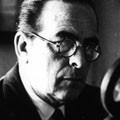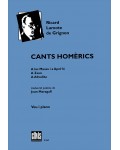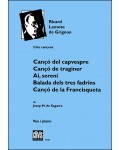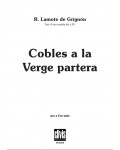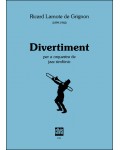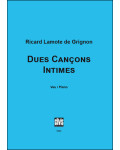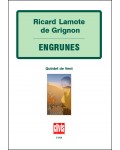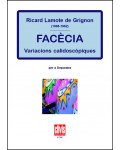
No products
Prices are tax included
Product successfully added to your shopping cart
There are 0 items in your cart. There is 1 item in your cart.
- English
- Castellano
- Català
Ricard Lamote de Grignon i Ribas was born in Barcelona in 1899. Son of Joan Lamote de Grignon i Bocquet, the conductor and composer of international renown, who influenced the vocation and education of his only child. He completed his musical education at the Conservatorio del Liceo and the Academia Marshall, both in Barcelona. At the age of 20, he joined the Orquesta Sinfónica de Barcelona and Orquesta del Gran Teatro del Liceo as a cellist. His first composition was the collection of pieces for piano, Engrunes. In 1930 he became the conductor of the Orquesta Sinfónica de Girona and two years later he successfully applied for a post as assistant conductor of the Banda Municipal de Barcelona. The vicissitudes of the Civil War prompted him to move to Valencia where he worked as assistant conductor of the city’s orchestra alongside his father, the orchestra’s founder and conductor. On his return to his hometown, after continuing to compose, he received several music commissions for over twenty films, and a large number of collaborations on radio programmes. Finally, in 1957, he was appointed as assistant conductor of the Orquesta Municipal de Barcelona alongside his good friend, Eduard Toldrà.
His work consists basically of symphonic works like Facècia (1936) which was awarded the Juli Garreta prize in 1938, Dos Petits Poemes, Cartell Simfònic (1936), Tres Sonates del Pare Soler or Simfonia Catalana (1950), among others, and Concierto Mágico, music for the film of the same name and Tríptico de la Piel de Toro, for both piano and orchestra. Ballets like El Rusc, first performed at the Gran Teatro del Liceo, Somnis (1929) or Un Prat, dedicated to his “father and maestro” and Divertiment (1936) for symphonic jazz orchestra. Large-scale operas like La Cabeza del Dragón (1939), first performed in 1959, with libretto by Valle-Inclán, and chamber operas like Le Petit Chaperon Vert, with French text by Marià Camí, or Màgia, whose libretto he wrote himself, first performed in 1952, and a children’s opera, La Flor, which premiered in 1934 and was performed again on several occasions. The symphonic poem Enigmes won the Premio Ciutat de Barcelona in 1950, as did his posthumous work El Càntic dels Càntics, completed before his death in 1962. His vocal music included works for voice and piano on poems by Carner and Maragall, among others, and choral pieces like Romance del Caballero, and the harmonisation of traditional songs. He also wrote small works for piano and several pieces for different instrumental ensembles like Toccata, which was awarded the Premio Santa Llúcia, 1957 de Juventudes Musicales, the work Goya, Six unpleasant pieces for ten soloists, and a series of pieces for different wind ensembles entitled Miniatures, designed as pre-rehearsal exercises for the instrumentalists of the Orquesta de Valencia.
-
-
-
Cinc cançons sobre poemes de Josep M. de...
Edition: DigitalThese poems have subtle irony that Lamote adjusted perfectly to their music. The famous soprano Mercè Plantada divulged these songs, so these became very popular.
10,76 € -
Cinc cançons sobre poemes de Josep M. de...
Edition: PrintedThese poems have subtle irony that Lamote adjusted perfectly to their music. The famous soprano Mercè Plantada divulged these songs, so these became very popular.
18,50 € -
-
-
Divertiment
Edition: DigitalThe structure of this Divertimento for orchestra of symphonic jazz is as follows: The 1st movement is an Allegro, with a joyful Fox rhythm; The 2nd movement, Moderato, has a Waltz time; The 3rd movement has a Slow tempo; Finally, the last movement is an Allegro molto, with a Ragtime rhythm.
21,81 € -
Dues Cançons Íntimes
Edition: PrintedThese two songs composed with more than ten years apart are part of the composer's personal life: Plugeta lleu (Fine Mist) is a hymn to nature, and A l'amic (To a Friend) is a tribute to friendship.
0,00 € -
Dues cançons íntimes
Edition: DigitalThese two songs composed with more than ten years apart are part of the composer's personal life: Plugeta lleu (Fine Mist) is a hymn to nature, and A l'amic (To a Friend) is a tribute to friendship.
6,35 € -
-
Engrunes
Edition: DigitalIt was originally a collection of twelve short pieces for piano. This version consists of six «crumbs» and the author transcribed it from the original for piano more than 25 years later.
16,64 € -

